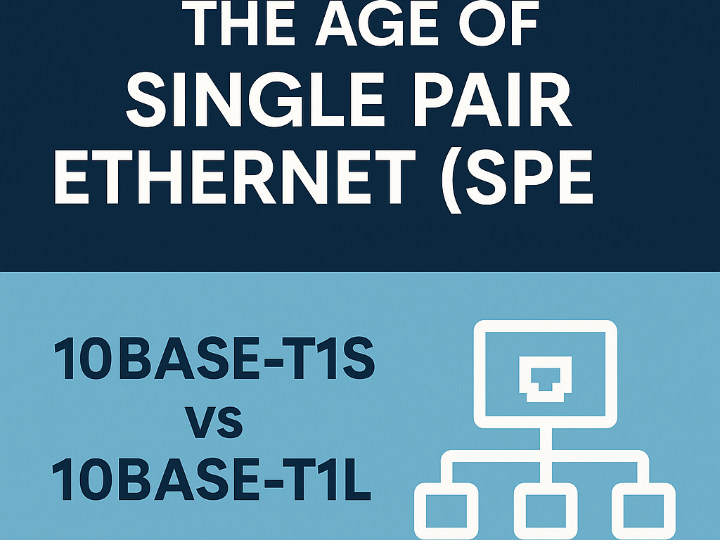🚀 The Age of Single Pair Ethernet (SPE): Complete Guide to 10BASE-T1S vs T1L
Single Pair Ethernet (SPE) is a next-generation communication technology that enables Ethernet connectivity over a single twisted pair of wires.

Single Pair Ethernet (SPE) is a next-generation communication technology that enables Ethernet connectivity over a single twisted pair of wires. It replaces bulky, heavy cabling systems while ensuring robust and stable networking across industries.
The IEEE 802.3cg standard defines two complementary SPE specifications: 10BASE-T1S and 10BASE-T1L. Each has distinct physical capabilities and target applications, designed to serve different yet complementary domains.
🔠 A Name With Meaning: Short vs. Long
The difference is in the name:
- "S" in 10BASE-T1S stands for Short-Reach
- "L" in 10BASE-T1L stands for Long-Reach
These labels reflect the optimized transmission range and deployment intent of each technology.
(e.g., 10BASE-T1S is ideal for short-range in-vehicle Ethernet, while 10BASE-T1L targets long-range industrial Ethernet communication)
🔍 10BASE-T1S: Optimized for Short Range and Multi-Drop Networks
10BASE-T1S enables connectivity across distances up to 25 meters. It supports multi-drop topologies, making it ideal for environments with numerous tightly packed nodes like vehicle networks or compact industrial devices.
Key Features
Speed: 10 Mbps
- Max Distance: 25 meters
- Duplex Mode: Half- or Full-Duplex
- Topology: Multi-drop or Point-to-Point
- Collision Avoidance: Uses PLCA (Physical Layer Collision Avoidance)
Applications
- Automotive sensor and actuator networks
- Internal device networks in machinery
- Localized robotics and control loops
Replaces Traditional Technologies
- LIN (Local Interconnect Network): Low-speed automotive network protocol typically used for body electronics.
- CAN (Controller Area Network): Widely used for in-vehicle networking and industrial automation.
- Short-distance RS-485: Serial communication often used in legacy automation systems for short-range, multi-drop setups.
- FlexRay: A time-deterministic communication protocol used in high-end automotive applications, which 10BASE-T1S can consolidate under Ethernet.
📅 Enhancing In-Vehicle Networks:
10BASE-T1S was designed for In-Vehicle Networking (IVN) systems. Modern cars integrate hundreds of sensors, actuators, lights, and switches, often managed by CAN, LIN, and other protocols. 10BASE-T1S aims to consolidate and streamline these systems.
- Short Range, High Density: Perfect for sub-15m environments within vehicles.
- Multi-Drop Efficiency: Enables multiple nodes on a single cable using PLCA.
- Lightweight Cabling: UTP cabling reduces harness size and vehicle weight.
- Robust EMI/EMC: Built for noisy automotive environments.
🔹 Key Insight: 10BASE-T1S brings standard Ethernet and multi-drop topology together to replace short-range fieldbus networks with a unified infrastructure.
🌐 10BASE-T1L: Long-Distance Ethernet for Industrial and Building Automation
10BASE-T1L delivers Ethernet communication over distances up to 1,000 meters. It enables seamless connectivity across sprawling industrial sites and building systems, replacing traditional analog or serial protocols.
Key Features
Speed: 10 Mbps
- Max Distance: 1,000 meters
- Duplex Mode: Full-Duplex
- Topology: Point-to-Point
- Power Delivery: PoDL (Power over Data Line) supported
- Encoding: PAM3
Applications
- Long-distance industrial automation
- Building automation systems (BAS, HVAC)
- Power-efficient remote sensor networks
Replaces Traditional Technologies
- RS-485, RS-422: Common serial standards used for robust industrial communication over moderate distances.
- CAN, CANopen: Legacy bus systems used in machinery and automation.
- Modbus RTU, Profibus DP: Widely adopted fieldbus systems used in process control and factory environments.
- HART, 4–20mA analog loops: Analog-based protocols used for simple sensor communications.
- FOUNDATION Fieldbus, PROFIBUS PA: Process automation networks that can be modernized with SPE while reusing existing cabling infrastructure.
📅 Transforming Industrial Ethernet:
10BASE-T1L shines in factory and building automation environments, where sensors, controllers, and power systems are spread across wide areas.
- Up to 1km Distance: Covers large-scale deployments effortlessly.
- PoDL Support: Delivers power and data through a single wire.
- Legacy Cabling Reuse: Works with existing fieldbus wiring (e.g., PROFIBUS PA).
- IT/OT Integration: Enables seamless communication from sensor to cloud.
🔹 Key Insight: 10BASE-T1L converges legacy serial/analog systems under the Ethernet umbrella for IIoT and smart factory modernization.
🖼️ Network Topologies in SPE: Multi-Drop vs Point-to-Point
To better illustrate the structural differences between 10BASE-T1S and T1L, the following diagram compares multi-drop and point-to-point network topologies.
In multi-drop configurations like 10BASE-T1S, multiple devices share a single cable segment, while 10BASE-T1L uses dedicated point-to-point links for each connection, suitable for longer distances and higher isolation.
🔎 Quick Comparison: T1S vs T1L
| Feature | 10BASE-T1S | 10BASE-T1L |
|---|---|---|
| Max Speed | 10 Mbps | 10 Mbps |
| Max Distance | 25 meters | 1,000 meters |
| Topology | Multi-drop / Point-to-Point | Point-to-Point |
| Duplex Mode | Half- or Full-Duplex | Full-Duplex |
| Power Delivery | Optional | Full PoDL Support |
| Applications | Automotive, machine-level sensors | Factory, building, process control |
| Replaces | LIN, CAN, RS-485, FlexRay | RS-485, HART, Modbus, 4–20mA, PROFIBUS, FOUNDATION Fieldbus |
🌟 Conclusion
SPE is not just about reducing wires — it's about simplifying networks and enabling Ethernet everywhere.
- 10BASE-T1S is ideal for high-density, short-range environments like vehicles and embedded machinery. It replaces legacy multi-drop fieldbus systems.
- 10BASE-T1L supports reliable, long-distance Ethernet communication across industrial and building environments. It modernizes decades-old analog and serial infrastructure.
By adopting SPE, industries move one step closer to realizing Ethernet to the Edge — bringing standard networking from sensors all the way to the cloud.
